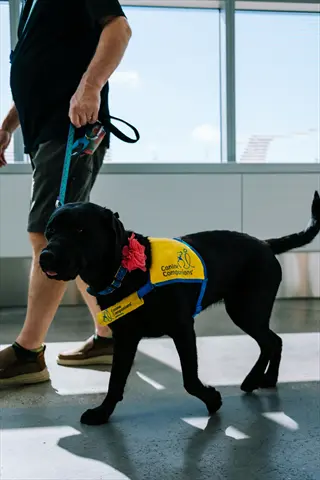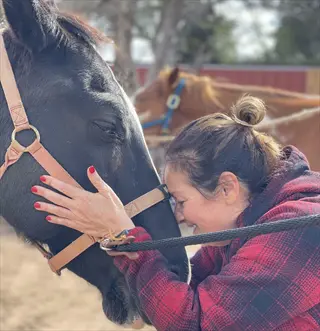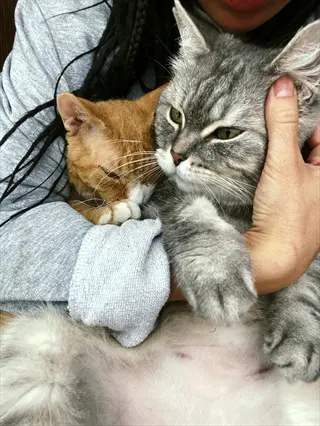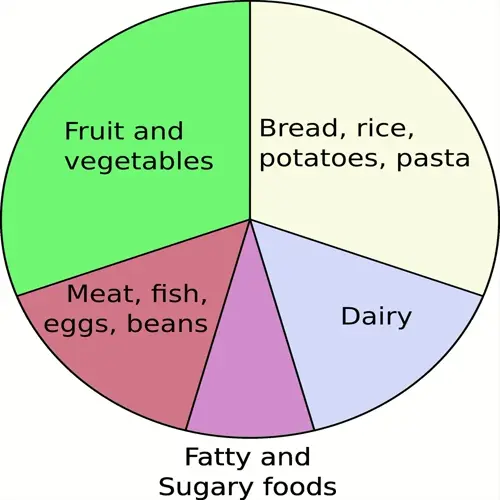Pet Therapy Benefits: A Comprehensive Guide

Written by
Natalie Hamilton
Reviewed by
Prof. Benjamin Murphy, Ph.D.The benefits of pet therapy are validated stress relief and emotional support, regardless of age.
There are many different species of animals that can provide specialized therapeutic interventions, not limited to dogs.
Physiological changes can be seen, including lower blood pressure measuring increased immune function.
Social relationships can be enhanced through facilitated ice-breaking with the animal or using the animals as the primary means of non-verbal communication.
Repeated sessions can show cumulative benefits and should be seen as part of treatment, rather than expecting instant results and change after one intervention.
Therapeutic animals should accompany licensed providers but the animal does not provide clinical intervention without a professional.
Article Navigation
To fully appreciate the advantages of pet therapy, consider it as animal-assisted therapy, utilizing trained animals. It is used to promote mental, emotional, and social well-being, not as a replacement for psychotherapy, prescription drugs, or other medical treatments. Pet therapy programs are found in hospitals, schools, and senior centers across the United States. Their focus is on improving the quality of life through structured human-animal interaction.
This means that we're taking a whole-person health view. It's comforting when things are painful. I've seen children who might have been traumatized and overwhelmed by human interaction turn to therapy dogs. Anyone can sign up for these programs, regardless of age or physical condition. They are secure spaces for emotional expression.
Studies demonstrate the effectiveness of these therapies, resulting in decreased stress and increased social interaction. My experience with hospice patients is that visits from animals alleviate feelings of loneliness. Nevertheless, these should be considered supportive therapies, as they complement traditional types of care.
Therapy Animal Species and Roles
Dogs are the most versatile of the therapy animals, being used in a variety of settings. They comfort disaster victims in hospitals and visit the classrooms. Their ability to reach and connect emotionally makes them the ideal partner. I have seen golden retrievers, quite worried students during examinations, who were better off than any pep talk they could have received.
Equine-assisted activities offer a strong form of therapy involving horses. Because of their large size, they require handling by qualified staff in specialized facilities. Programs that utilize horses help veterans develop self-esteem, while also aiding children in improving their motor coordination skills. Horses create spaces for trust to grow, promoting increased capacity for stability and strength of body while riding.
Small animals, such as guinea pigs and rabbits, provide unique benefits for children. Their small size comforts anxious children during therapy sessions. Gentle petting helps children learn responsibility and empathy. For children with sensory processing problems, I recommend these animals.
Farm animals offer a novelty factor, which tends to engage reluctant participants. Goats, chickens, and alpacas provide memorable experiences in residential facilities. Their care creates a daily structure. These interactions may also bring about breakthroughs in group therapy situations.

Dogs
- Dogs serve as the most common therapy animals due to their exceptional trainability and natural social connection abilities with humans.
- Certified therapy dogs undergo extensive obedience training to remain calm in busy environments like hospitals, schools, and nursing homes during sessions.
- Specific breeds including Golden Retrievers and Labradors are frequently selected for their gentle temperament and patient disposition during interactions.
- Therapy dogs significantly reduce anxiety and stress levels through physical presence and tactile contact during therapeutic interventions.
- Regular interactions with therapy dogs consistently lower blood pressure and reduce cortisol levels in participants across all age groups.
- These animals participate in specialized reading programs where children practice literacy skills by reading aloud to the animal without judgment.

Horses
- Equine-assisted therapy utilizes horses for both physical rehabilitation and emotional growth through structured grooming and riding activities.
- The substantial size and distinctive movement of horses provide unique sensory input that improves balance and coordination skills.
- Participants consistently develop confidence and emotional regulation by learning to communicate non-verbally with these powerful yet gentle animals.
- Therapeutic riding programs specifically help individuals with physical disabilities strengthen core muscles and improve joint flexibility.
- Ground-based activities with horses including feeding and leading teach responsibility through consistent care routines during sessions.
- Equine therapy requires specialized facilities with trained professionals to ensure absolute safety during all animal interactions.

Small Animals
- Rabbits and guinea pigs offer gentle therapy options with their quiet nature and soft fur texture that comforts participants.
- Their compact size makes them ideal for bedside visits in hospitals or classroom settings with young children.
- Holding and petting these animals provides tactile comfort that effectively reduces anxiety and promotes deep relaxation responses.
- These animals prove particularly effective for individuals with limited mobility who cannot engage with larger therapy animals.
- Guinea pigs respond positively to gentle handling and frequently form strong emotional bonds with regular visitors over time.
- Therapy sessions with small animals typically focus on sensory stimulation and emotional connection through calm interactions.

Cats
- Therapy cats deliver comfort through low-frequency purring vibrations scientifically proven to reduce human stress levels.
- These animals excel in long-term care facilities by providing companionship to residents who previously owned feline pets.
- The naturally quiet disposition of cats creates peaceful environments for individuals experiencing noise sensitivity issues.
- Cats typically initiate contact on their own terms, teaching participants about consent and healthy personal boundaries.
- Regular visits from therapy cats significantly reduce agitation in dementia patients and improve overall mood metrics.
- Handler protocols require scheduled breaks every 45 minutes to prevent stress during therapeutic intervention sessions.

Farm Animals
- Farm animals including goats and chickens offer unique therapeutic experiences through structured caregiving activities.
- Feeding and grooming routines with these animals effectively promote responsibility and establish daily structure.
- The novelty factor of farm animals creates valuable engagement opportunities for reluctant therapy participants.
- Activities like collecting eggs or brushing goats provide purposeful physical movement that enhances motor skills.
- These animals thrive in outdoor settings that encourage nature connection during therapeutic intervention programs.
- Farm animal therapy frequently incorporates social components through group caregiving activities and shared responsibilities.

Birds
- Parrots and smaller birds provide unique auditory therapy through vocalizations and song mimicry capabilities.
- These animals offer low-impact interaction opportunities for individuals with severe physical mobility limitations.
- Teaching birds simple tricks promotes cognitive engagement and improves fine motor skills during sessions.
- Colorful plumage provides visual stimulation that enhances mood and encourages verbal communication attempts.
- Birds require specialized handlers familiar with avian behavior to ensure safe therapeutic interactions.
- Feeding activities with birds develop responsibility and routine-following skills in participants.

Dolphins
- Dolphin-assisted therapy utilizes aquatic environments to provide unique sensory experiences during interventions.
- Water-based interactions promote physical therapy through controlled movements and resistance training.
- These intelligent mammals form strong connections that encourage social engagement in participants.
- Therapy requires specialized coastal facilities with controlled access to ensure animal welfare standards.
- Sessions typically incorporate structured activities like signaling behaviors and synchronized swimming.
- Aquatic therapy demonstrates particular effectiveness for individuals with autism spectrum conditions.

Llamas
- Llamas serve as calm therapy animals known for their gentle demeanor and unusual appearance.
- Walking activities with llamas provide physical exercise that improves cardiovascular health and balance.
- Their distinctive appearance creates natural conversation starters that enhance social interactions.
- Grooming sessions develop fine motor skills through brushing and mane care techniques.
- Llamas require handlers experienced with camelid behavior to ensure safe therapeutic encounters.
- These animals demonstrate exceptional patience during interactions with children and elderly participants.

Miniature Pigs
- Miniature pigs offer intelligent companionship with their problem-solving abilities and affectionate nature.
- Training sessions involving obstacle courses develop cognitive skills and physical coordination.
- Their compact size allows accessibility in various settings including hospitals and schools.
- Grooming activities promote sensory integration through tactile contact with bristly fur.
- Pigs require consistent reinforcement training to maintain appropriate therapeutic behaviors.
- These animals demonstrate strong food motivation that enables effective reward-based training.

Alpacas
- Alpacas provide gentle therapy with their soft fleece and calm behavioral characteristics.
- Fiber collection activities teach participants about sustainable material use and craftsmanship.
- Their non-confrontational nature creates low-stress interactions for anxious individuals.
- Walking sessions promote physical activity while developing responsibility through leading exercises.
- Alpacas require specialized handling techniques distinct from other therapy animal species.
- Group activities with alpacas encourage teamwork and communication skill development.
Science Behind the Benefits
The science behind pet therapy benefits starts with the reduction of cortisol. Physical contact with animals significantly reduces this stress hormone. Within minutes of the interaction, your body begins to move toward relaxation. This physiological change is measurable in blood and saliva testing. I have monitored these changes in my clinical work.
The release of oxytocin results in strong social-bonding effects. The hormone is released with animal-to-animal interaction, allowing for trust and connection. After the sessions, humans are more open to socializing. This is the reason that isolated individuals benefit from therapy animals. The chemistry of the connection is real.
Your heart is healthier through parasympathetic activation. The nervous system response decreases heart rate and blood pressure. Contact with an animal naturally creates this response. I've observed patients' blood pressure drop by up to ten points during sessions. The body goes into recovery mode.
Therefore, repeated sessions build neural plasticity. The brain forms new pathways to cope with emotions and facilitate socialization. Through the repetition, the changes are strengthened. It is essential to have consistent sessions to create lasting changes. The brain will structure itself in a way to meet its needs through positive interaction with the animals.
Hormonal Regulation Pathways
- Oxytocin release during animal interactions creates bonding hormones that reduce stress and increase social trust immediately following contact.
- Cortisol levels decrease significantly within 20 minutes of animal interaction, lowering measurable stress markers in blood and saliva samples.
- Serotonin and dopamine neurotransmitters increase during therapy sessions, creating natural mood elevation without pharmaceutical intervention.
Neurological Effects
- Prefrontal cortex activity patterns shift toward emotional regulation during animal interactions, improving impulse control and decision-making capabilities.
- Mirror neuron systems activate when observing animal behaviors, enhancing empathy development and social cognition in participants.
- Repeated therapy sessions strengthen neural pathways associated with positive social interactions, creating lasting behavioral changes.
Cardiovascular Benefits
- Blood pressure decreases by 10 to 20 mmHg during sessions through parasympathetic nervous system activation that counters stress responses.
- Heart rate variability patterns shift toward healthier coherence, indicating improved autonomic nervous system function and resilience.
- Peripheral vasodilation occurs during animal contact, improving circulation and oxygen delivery to tissues throughout the body.
Stress Response Modulation
- The amygdala's threat response activity decreases during animal interactions, reducing fight-or-flight reactions to everyday stressors.
- HPA axis regulation improves with consistent therapy, normalizing cortisol production patterns throughout the daily cycle.
- Respiratory patterns synchronize with animal breathing rhythms, creating physiological coherence that lowers anxiety levels naturally.
Social and Behavioral Pathways
- Nonverbal communication skills develop through interpreting animal body language, transferring to improved human social interactions.
- Responsibility and routine establishment through animal care tasks create structure that benefits executive functioning skills.
- Social initiation behaviors increase significantly in group therapy settings with animals serving as social catalysts.
Immune System Enhancement
- Immunoglobulin A levels increase significantly after consistent therapy sessions, strengthening mucosal immunity defenses.
- Natural killer cell activity improves through reduced stress hormones, enhancing immune surveillance against pathogens.
- Inflammatory markers like C-reactive protein decrease measurably after eight weeks of regular animal interactions.
Emotional and Mental Wellness
Tactile illicit differentials with therapy animals create excellent relief from anxiety. Rubbing the animal induces rhythmic motions that gather the scattered thoughts. The body stores up tension, and release is facilitated by touch. I've witnessed panic attacks subside in minutes in therapy dog sessions. The groundwork is instantaneous.
Animals provide unconditional companionship that is rarely matched in human interactions. They accept you without criticism or expectation. This type of unconditional support helps offset habitual negative self-talk. When you develop routines of care that give purpose, depressive moods lift. Animals meet you where you are in your feelings.
Animals construct secure emotional containers for recovering from trauma. They rebuild trustworthy relationships through predictable responses. I have watched veterans tell their stories to horses that they would never share with their coach or therapist. Animals allow the processing of trauma without increasing pressure to verbalize the pain.
Animal visits effectively help fight loneliness and provide consistent companionship. They fill in the social gap between people. Touch deprivation lessens with safe physical contact. Regular visits fulfill basic human needs for social connection and interaction. Isolation shrinks from one visit at a time.
Anxiety Reduction
- Tactile interactions with therapy animals lower physiological stress markers within 15 minutes of contact.
- Rhythmic petting motions create meditative states that calm racing thoughts and reduce panic symptoms.
- Animal presence provides grounding during emotional overload through sensory anchoring techniques.
Depression Alleviation
- Non-judgmental companionship counters negative self-talk patterns common in depressive states.
- Caregiving routines establish purpose and structure that combat motivational deficits.
- Play interactions trigger dopamine release creating natural mood elevation without medication.
Trauma Recovery Support
- Animals create safe emotional containers for processing difficult memories without pressure.
- Non-verbal communication builds trust incrementally for those with relational trauma histories.
- Predictable animal responses help recalibrate hypervigilance toward healthier awareness levels.
Loneliness Mitigation
- Consistent animal visits reduce perceived isolation through reliable companionship bonds.
- Animal interactions serve as social catalysts that bridge connections between people.
- Touch deprivation alleviates through safe physical contact satisfying fundamental needs.
Emotional Regulation
- Animal mirroring helps participants recognize and name emotional states in real-time.
- Calming animal presence creates pause between stimulus and reaction during distress.
- Synchronized breathing patterns with animals establish physiological coherence quickly.
Grief Processing
- Animals provide silent companionship that validates loss without requiring conversation.
- Tactile comfort offers physical expression when words feel inadequate or overwhelming.
- Routine care activities restore structure during disorienting life transitions.
Physical Health Improvements
Grooming activities with therapy animals are a potent booster of motor skills development for children. Brushing coats or buckling harnesses improves fine motor skill control and coordination. The muscles involved are multiple muscle groups, and the action requires concentration and coordination. I have seen people with strokes gain greater dexterity through the daily routines of caring for rabbits. The physical use helps to build up strength gradually.
The interaction with the animal triggers the release of endorphins, which naturally mitigate pain perception. Natural substances are present that produce analgesia without the need for drugs. Patients who undergo therapy in the presence of therapy animals report that their discomfort during procedures is 30% less. This relief results from a combination of the distraction of the animals and the biochemical changes that occur.
Regular dog walking therapy helps improve cardiovascular health. Continuous movement has a direct effect on blood pressure, lowering it and improving heart rate variability. A structured program provides 150 minutes of moderate exercise per week. This is an effective level of activity to help maintain long-term heart health.
Studies prove immune system enhancement due to animals. The decrease in stress hormones leads to better efficiency of the killer cells. The measurable increase in immunoglobulin A levels, the primary agents of immunity, indicates improvement after continued sessions. During the time of contact, the body's defenses are enhanced through biological processes that are triggered.
Pain Perception Reduction
- Endorphin release decreases pain sensitivity by 30% to 40% (≈1/3 reduction) during medical procedures
- Distraction from discomfort occurs through tactile focus shifting attention away from physical suffering
- Relaxation responses lower muscle tension that commonly amplifies chronic pain conditions
Motor Skills Enhancement
- Grooming activities develop fine motor control through brushing, combing, and fastener manipulation tasks
- Throwing toys or balls improves gross motor coordination and upper-body range of motion
- Obstacle course navigation with animals enhances balance and spatial awareness capabilities
Cardiovascular Health
- Regular dog walking sessions increase moderate physical activity by 150 minutes weekly (≈2.5 hours)
- Blood pressure reductions of 10 to 15 mmHg (systolic) occur consistently during animal interactions
- Heart rate variability patterns shift toward healthier coherence during therapy sessions
Rehabilitation Acceleration
- Motivation to complete physical therapy exercises increases by 70% (≈2/3 higher) with animal participation
- Joint flexibility improves through repetitive reaching and petting motions during sessions
- Recovery timelines shorten through consistent engagement in movement-based activities
Immune System Boost
- Immunoglobulin A levels increase by 20% (≈1/5 higher) after eight weeks of regular therapy sessions
- Natural killer cell activity improves through stress hormone reduction pathways
- Inflammatory markers decrease significantly with consistent animal interaction schedules
Respiratory Benefits
- Breathing patterns synchronize with animal rhythms improving lung capacity efficiency
- Respiratory rates decrease by 20% (≈1/5 reduction) during therapy indicating relaxation responses
- Oxygen saturation levels increase measurably after 30 minutes of interaction
Social Connection Strategies
Therapeutic animals serve as natural icebreakers in groups. They always present neutral, benign subjects for general conversation, which disperses social or specific anxiety. People are inclined to share their common experiences with animals. I have witnessed smart groups in group therapy become animated when I bring a golden retriever into the group.
For neurodiverse people, animals present opportunities for non-verbal communication. Learning to interpret animal body language expands the range of observational skills needed in human interaction. Silent walks in the outdoors present the chance to gain comfort without speaking. Animals become safe partners in practice for developing social confidence at your own rate.
The relationships differ in that they are based on a shared interest in animal activities and grooming rituals, which create cooperative obligations. When family members participate in "fetch" games, they bond through the communal reflection of good times. It is through these simple associations with living, feeling animals that bonds broken because of daily coping mechanisms become reestablished.
Programs achieve inclusion for animals in community-related activities. Intergenerational activities connect youth and older adults to animals for care. Therapy sessions open to the public bring isolated individuals into social areas. Animals serve as bridges across cultural differences, fostering a sense of belonging among diverse age groups.
Group Therapy Ice-Breaking
- Animals create neutral conversation starters that reduce social anxiety in new group settings
- Shared care activities like group grooming establish immediate common ground among participants
- Animal-focused discussions allow gradual personal sharing without direct emotional exposure
Non-Verbal Communication
- Interpreting animal body language teaches observation skills transferable to human interactions
- Minimal-verbal activities like silent walking build comfort with non-verbal connection
- Animals provide safe practice partners for those developing social confidence
Family Bonding Activities
- Joint animal care routines establish cooperative responsibilities among family members
- Shared positive experiences during play create positive association memories
- Animal-centered problem-solving activities develop collaborative communication skills
Community Inclusion
- Public animal therapy events create accessible social spaces for isolated individuals
- Intergenerational programs connect seniors and youth through shared animal activities
- Animal-assisted literacy programs build confidence in community participation
Social Skill Development
- Role-playing with animals practices initiating and maintaining conversations
- Reading animal cues improves emotional intelligence and empathy capabilities
- Group training activities teach turn-taking and collaborative decision-making
Conflict Resolution
- Animals create neutral mediators during difficult interpersonal discussions
- Joint problem-solving around animal care redirects confrontational energy
- Calming animal presence lowers defensive reactions during challenging conversations
5 Common Myths
The false idea is that dogs are the only effective therapy animals because they are unique in their ability to be trained and are social.
Other species of animals are capable of working in structured programs including cats, horses, birds, rabbits and farm animals. Cats create a calming companionship. Horses perhaps are the best at assisting man's rehabilitation through the medium of physical therapy. Small animals assist children in developing a sense of empathy. Each species presents unique benefits which are suited to various therapeutic programs demonstrating that effectiveness is not limited to the dog.
A very common misconception is that pet therapy results are based on anecdotal experience with no scientific evidence.
Decades of research have shown physiologic benefits including the reduction of cortisol, improvement in blood pressure, and an enhancement of the immune response. Moreover, over 200 studies published in scientific, peer-reviewed journals show that the emotional benefits including anxiety reduction and socialization factors are enhanced. These combined findings provide evidence that animal-assisted therapy is an evidence-based, complementary form of therapy within professional healthcare.
Therapy animals can completely replace human therapists for treating mental health conditions effectively.
Animals serve as complementary partners to human professionals rather than replacements, facilitating emotional openness during sessions. Licensed therapists remain essential for diagnosis, treatment planning, and clinical interventions while animals help build rapport and engagement. The animal-human team approach enhances traditional methods but doesn't eliminate the need for professional psychological expertise.
Any affectionate companion animal in the household has the temperament and expertise necessary for certification as a therapy pet.
Certified therapy animals go through elaborate temperament tests, specialized training for unpredictable environments, and wanted health examinations are more advanced than the ordinary tests of training. These pets must be able to keep their calm amid the shattering of medical equipment, sudden movement, and strange methods of handling. The various methods of testing enforce standards which can not generally be duplicated by unqualified pets.
Pet therapy has both immediate and lasting effects from just one encounter
Some effects, like reduced anxiety, occur after the sessions, but permanent effects arise from contact continued over weeks or months. Research shows that the results from contact increase in a cumulative way, such as steady blood pressure decrease or enhanced social skills development. The therapeutic goals in structured programs rather than looking for permanent results from single sessions.
Conclusion
The comprehensive advantages of therapy benefits for cardiovascular health encompass physical, psychological, and social health. All results indicate that interactionist improvement favours whole health. You experience reduced stress, increased mental clarity, and improved cardiovascular and physical function, as well as social benefits. It is these combined advantages of social interaction that make animal-assisted therapy a unique and beneficial facility for whole health.
These programs are accessible to various groups of people in diverse settings. The schools, the hospitals, and the centers implement successful interventions. No age or disability creates a barrier to participation. I have noticed that programs are beautifully adaptable for both wheelchair patients and those with dementia.
It is important to always consult professionals prior to commencing therapy programs. Licensed and/or certified handlers ensure the welfare of the animals and the safety of the participants, while ensuring that the animal used is aligned with the respective therapeutic goals. This professional guidance will help ensure the program's efficacy and prevent issues and dangers during practice.
Recall that benefits build through consistent engagement. Sessions span time and represent change, while benefits are durable and lasting improvements, not fleeting interactions. Consistent participation produces consistent benefits. True, profound transformation does not occur overnight, but is evident over weeks and months of structured work.
External Sources
Frequently Asked Questions
What are the core pet therapy benefits for mental health?
Pet therapy benefits include significant anxiety reduction, depression relief, and emotional regulation through biological mechanisms like cortisol reduction and oxytocin release. Animals provide non-judgmental companionship that counters negative thought patterns while improving social connection.
How does animal interaction reduce human stress levels?
Physical contact with therapy animals triggers measurable physiological changes: lowered cortisol, reduced blood pressure, and regulated breathing patterns. Tactile stimulation activates the parasympathetic nervous system within minutes, creating calming effects that diminish fight-or-flight responses.
Who benefits most from animal-assisted therapy programs?
Key beneficiaries include:
- Elderly individuals combating loneliness
- Children developing social-emotional skills
- Trauma survivors rebuilding trust
- Patients managing chronic pain
- Neurodiverse individuals enhancing communication
Are certain animals more effective for therapy than others?
Diverse species provide unique therapeutic advantages: dogs offer high engagement, horses support physical rehabilitation, cats deliver calming vibrations, while small animals assist with sensory integration. Effectiveness depends on matching animal strengths to participant needs.
Can pet therapy replace traditional mental health treatment?
Animal-assisted interventions complement but don't replace clinical therapies. They enhance traditional methods by building rapport and engagement, while licensed professionals remain essential for diagnosis, treatment planning, and addressing complex psychological conditions.
What scientific evidence supports pet therapy effectiveness?
Over 200 peer-reviewed studies document physiological benefits like immune response enhancement and psychological improvements including reduced anxiety. Research confirms measurable changes in biomarkers like cortisol and blood pressure during structured animal interactions.
How do therapy animals facilitate social connections?
Animals serve as social catalysts by:
- Providing neutral conversation starters
- Enabling non-verbal communication practice
- Creating shared group activities
- Bridging generational gaps
- Reducing interpersonal anxiety
What are limitations of animal-assisted therapy?
Key considerations include animal welfare requirements, allergy concerns, and the need for professional oversight. Programs require certified animals with specialized training, and results accumulate through consistent sessions rather than immediate transformations.
Do pets inherently qualify as therapy animals?
No, therapy animals undergo rigorous temperament testing and specialized training beyond basic obedience. Certification requires demonstrated calmness in unpredictable environments, health screenings, and handler education through recognized organizations.
How does animal interaction benefit physical health?
Documented physical improvements include enhanced motor skills through grooming activities, cardiovascular benefits from walking therapies, pain perception reduction via endorphin release, and immune system strengthening through stress hormone regulation.

